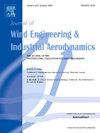Deep probabilistic modeling of environment-dependent tropical cyclone intensity evolution using Flow generative models
IF 4.9
2区 工程技术
Q1 ENGINEERING, CIVIL
Journal of Wind Engineering and Industrial Aerodynamics
Pub Date : 2025-06-04
DOI:10.1016/j.jweia.2025.106127
引用次数: 0
Abstract
In this study, Flow-based deep generative models are developed to simulate the environment-dependent tropical cyclone (TC) intensity evolution. Leveraging Flow’s unique capability to tractably model complex probability distributions, a conditional randomization test was first implemented to reduce the TC intensity dependency from a large pool of fifteen candidate variables to five significant ones. Then, a conditional Flow model was developed to guide the over-ocean environment-dependent TC intensity evolution, and an enhanced land decay model was developed for over-land evolution. 963 storms from China Meteorological Administration (CMA) dataset during 1980 to 2022 were used to develop and evaluate the Flow-based simulation framework in the Western Northern Pacific (WNP) basin. Overall, the proposed approach showed an excellent fit with historical observations in terms of hindcasting performance, simulated TC key statistics, TC spatial distributions, and the probability distributions of 6-h and 24-h intensity change. Flow-based models also competed favorably over existing stochastic linear regression models or Hidden Markov Models. Finally, a site-specific simulation validation along the China coastline showcased its potential for TC wind disaster assessment.
基于流量生成模型的环境相关热带气旋强度演变的深度概率模拟
本文采用基于气流的深度生成模型来模拟环境相关的热带气旋(TC)强度演变。利用Flow对复杂概率分布建模的独特能力,首先实现了条件随机化测试,将TC强度依赖性从15个候选变量的大池减少到5个重要变量。然后,建立了一个条件流模型来指导海洋上环境相关的TC强度演变,建立了一个增强的陆地衰减模型来指导陆地上环境相关的TC强度演变。利用中国气象局(CMA) 1980 - 2022年963次风暴数据集,开发和评估了西北太平洋(WNP)流域基于流量的模拟框架。总体而言,该方法在后推算性能、模拟TC关键统计量、TC空间分布以及6 h和24 h强度变化的概率分布方面与历史观测值具有很好的拟合性。基于流的模型也优于现有的随机线性回归模型或隐马尔可夫模型。最后,沿着中国海岸线进行了特定地点的模拟验证,展示了其用于TC风灾害评估的潜力。
本文章由计算机程序翻译,如有差异,请以英文原文为准。
求助全文
约1分钟内获得全文
求助全文
来源期刊
CiteScore
8.90
自引率
22.90%
发文量
306
审稿时长
4.4 months
期刊介绍:
The objective of the journal is to provide a means for the publication and interchange of information, on an international basis, on all those aspects of wind engineering that are included in the activities of the International Association for Wind Engineering http://www.iawe.org/. These are: social and economic impact of wind effects; wind characteristics and structure, local wind environments, wind loads and structural response, diffusion, pollutant dispersion and matter transport, wind effects on building heat loss and ventilation, wind effects on transport systems, aerodynamic aspects of wind energy generation, and codification of wind effects.
Papers on these subjects describing full-scale measurements, wind-tunnel simulation studies, computational or theoretical methods are published, as well as papers dealing with the development of techniques and apparatus for wind engineering experiments.

 求助内容:
求助内容: 应助结果提醒方式:
应助结果提醒方式:


